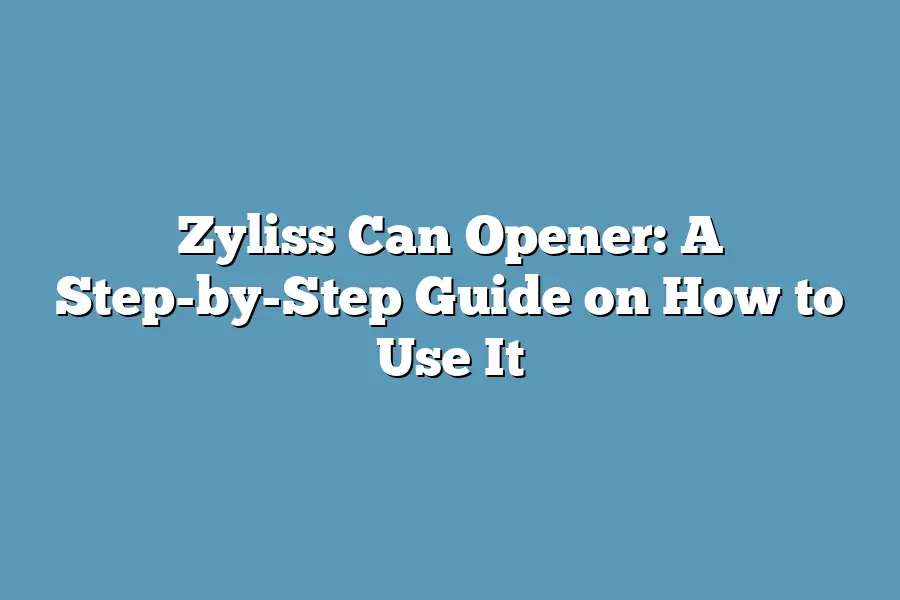Zyliss is a high-quality can opener that makes opening canned goods easy and safe. To use it, first place the can on a stable surface and position the Zyliss opener on top of the can, aligning the cutting wheel with the edge of the lid. Turn the handle clockwise until the lid begins to separate from the can, then lift the lid off completely. The remaining edges can be easily removed with your fingers or a knife.
As a home cooking enthusiast and self-proclaimed kitchen ninja, I’ve always been fascinated by the humble can opener.
It may seem like a simple tool, but trust me, it’s a game-changer when it comes to meal prep and cooking efficiency.
That’s why I’m excited to share my expertise on how to get the most out of Zyliss Can Opener – the ultimate kitchen companion for any home cook or busy parent.
From cleaning and preparing this essential device to mastering the art of can-opening itself, I’ll be covering everything you need to know to make mealtime a breeze.
So, whether you’re a seasoned chef or just starting your culinary journey, grab a cup of coffee, get comfortable, and let’s dive into the world of Zyliss Can Opener!
Table of Contents
Preparing for Use: The Ultimate Guide to Mastering Your Zyliss Can Opener
Before you start opening cans like a pro, it’s essential to prepare your trusty Zyliss Can Opener for action.
I’m not talking about just slapping it together with some canned goods; no way!
You need to make sure this baby is clean, sanitized, and ready to take on the toughest of tin containers.
Cleaning and Sanitizing: The First Step to a Happy Can-Opening Experience
Let’s face it: can openers can be breeding grounds for bacteria and germs.
Yikes!
That’s why it’s crucial to give your Zyliss Can Opener a good cleaning before each use.
Here are some top tips to get you started:
- Wipe it down: Use a damp cloth to wipe away any debris, crumbs, or spills that might have accumulated on the device.
- Soap and water: Mix some mild soap with warm water, and gently scrub the can opener’s surface, paying extra attention to any crevices or grooves. Rinse thoroughly with clean water, making sure to remove any soap residue.
- Vinegar and water: For a deeper clean, mix equal parts white vinegar and water in a bowl. Soak the can opener for about 10-15 minutes, then rinse it with clean water.
Now, you might be thinking, “But what about all those pesky little parts?
How do I get them squeaky clean?” Ah, great question!
For those tiny crevices and small parts, use a toothbrush or a small, soft-bristled brush to gently sweep away any debris.
And don’t forget to dry your can opener thoroughly with a lint-free cloth or paper towel to prevent any water spots.
Warning Signs: When It’s Time to Replace or Repair
Even the best can openers need some TLC every now and then.
Keep an eye out for these warning signs that it might be time to replace or repair your trusty Zyliss Can Opener:
- Rust: If you notice any rust spots or corrosion on the device, it’s likely time to retire it. Rust can spread quickly, compromising the structural integrity of the can opener.
- Loose parts: If any of the small parts start to loosen or fall off, it might be a sign that the can opener is nearing the end of its lifespan. Time to upgrade!
- Difficulty opening cans: If your can opener starts struggling to open even the easiest of cans, it might be time to consider replacing it.
Overview of Parts and Components: The Anatomy of Your Zyliss Can Opener
Now that we’ve covered cleaning and sanitizing, let’s take a closer look at the anatomy of your Zyliss Can Opener.
Here are the main parts you’ll need to know:
- Main body: This is the core of the can opener, where all the magic happens.
- Wheel: The wheel helps guide the can opener as it opens the can. Make sure it’s securely attached to avoid any accidents!
- Handle: The handle provides a comfortable grip for easy handling and storage.
- Sharpening mechanism: This is where the can opener does its magic, slicing through even the toughest of cans.
To keep your Zyliss Can Opener in top shape, make sure to store it properly when not in use.
Here are some pro tips:
- Handle with care: Store the can opener in a dry place, away from direct sunlight or moisture.
- No crushing allowed: Avoid storing the can opener on its side or crushing it under heavy objects.
- Clean and dry: Always clean and dry your can opener before storing it to prevent any bacterial growth.
There you have it – the ultimate guide to preparing for use with your Zyliss Can Opener!
By following these simple tips, you’ll be well on your way to becoming a can-opening master.
Happy cooking!
Opening a Can with Zyliss Can Opener: A Smooth Sailing Guide
When it comes to opening cans, I’ve encountered my fair share of struggles.
From rusty lids to slippery surfaces, it’s easy to get frustrated and end up with a mess on your hands (or kitchen counter).
But fear not!
With the trusty Zyliss Can Opener by your side, you’ll be effortlessly opening cans in no time.
Step-by-Step Instructions: Opening a Can Like a Pro
Let’s dive into the step-by-step process of using the Zyliss Can Opener.
Follow these simple tips to ensure a smooth and spill-free experience:
Grip It Right: To begin, place your non-dominant hand on top of the can, with your fingers spread evenly around the circumference.
This will give you a stable grip as you open the can.
Make sure not to put too much pressure, as this might cause the opener to slip.
Keep Fingers Away: Remember, the cutting wheel is where the magic happens – but it’s also where messes are born!
Keep your fingers away from the spinning blade by placing them on either side of the can or, better yet, using a towel to guide the lid off.
Trust me, you don’t want any accidental nips!
Effortless Opening: Now it’s time to put the Zyliss Can Opener to work!
Place the opener on top of the can, aligning the cutting wheel with the edge of the lid.
Gently push down and twist the opener in a smooth motion.
The lid should start to come off effortlessly, leaving you with a perfectly opened can.
With these simple steps and tips, you’ll be opening cans like a pro in no time!
The Zyliss Can Opener truly makes short work of even the most stubborn lids.
So go ahead, give it a try, and experience the joy of mess-free cooking!
Additional Tips and Tricks: Unlocking the Full Potential of Your Zyliss Can Opener
Now that you’ve mastered the basics of using your trusty Zyliss Can Opener, it’s time to take your skills to the next level.
In this section, I’ll share some additional tips and tricks to help you tackle even the stickiest or most stubborn cans with ease.
Mastering Different Types of Cans: From Pop-Tops to Pull-Tabs
The Zyliss Can Opener is designed to be versatile, and that’s reflected in its ability to open a wide range of can types.
But did you know that different cans require slightly different techniques?
That’s right – the same tool can be used for both pop-top and pull-tab cans, but the approach might vary.
For pop-top cans, simply place the opener on top of the lid and twist it counterclockwise until the top comes off.
Easy peasy!
Pull-tab cans, on the other hand, require a bit more finesse.
Place the opener under the tab and apply gentle downward pressure while twisting the tool to the left.
With a bit of patience and practice, you’ll be opening those pesky pull-tabs like a pro.
Handling Sticky or Stubborn Cans: Tips for Success
We’ve all been there – trying to open a can that just won’t budge.
But fear not, my friends!
The Zyliss Can Opener is designed to handle even the stickiest of situations.
Here are some tips to keep in mind:
- Don’t be afraid to get a little aggressive: Sometimes, those stubborn cans need a bit more persuasion than usual. Just be sure to use gentle yet firm pressure – you don’t want to damage the can or the opener.
- Cleanliness is key: Make sure your Zyliss Can Opener is clean and free of any debris that might interfere with its performance. A quick rinse under warm water should do the trick.
- Lubricate if necessary: If you’re dealing with a particularly sticky can, try applying a small amount of lubricant (like cooking spray or olive oil) to the area where the opener meets the lid.
Common Mistakes to Avoid: The Consequences of Not Following Proper Usage Guidelines
While the Zyliss Can Opener is an incredibly versatile tool, there are some common mistakes that can lead to frustration and even damage.
Here are a few to watch out for:
- Over-tightening: Don’t be tempted to apply too much pressure – you might end up damaging the opener or stripping the lid.
- Insufficient lubrication: Failing to clean your Zyliss Can Opener regularly can lead to rust and corrosion, reducing its effectiveness over time.
- Not reading the instructions: I know it’s tempting to dive in headfirst, but taking a few minutes to read through the user manual will help you avoid common pitfalls and get the most out of your tool.
By following these simple tips and tricks, you’ll be well on your way to becoming a Zyliss Can Opener master.
And remember – with great power comes great responsibility!
Use your newfound skills wisely, and always keep in mind that a little patience and practice can go a long way.
Final Thoughts
As I wrap up this step-by-step guide on how to use the Zyliss Can Opener, I’m reminded that sometimes it’s the little things in life that make a big difference.
A can opener may seem like a mundane tool, but with proper usage and care, it can be a game-changer for anyone who cooks or prepares meals regularly.
By following the tips and tricks outlined in this post, you’ll be well on your way to becoming a can-opening master.
Remember to clean and maintain your Zyliss Can Opener, store it properly, and use it with confidence.
With these simple habits, you’ll be opening cans like a pro in no time – and enjoying the satisfaction of knowing that your meals are just a cut above the rest.


